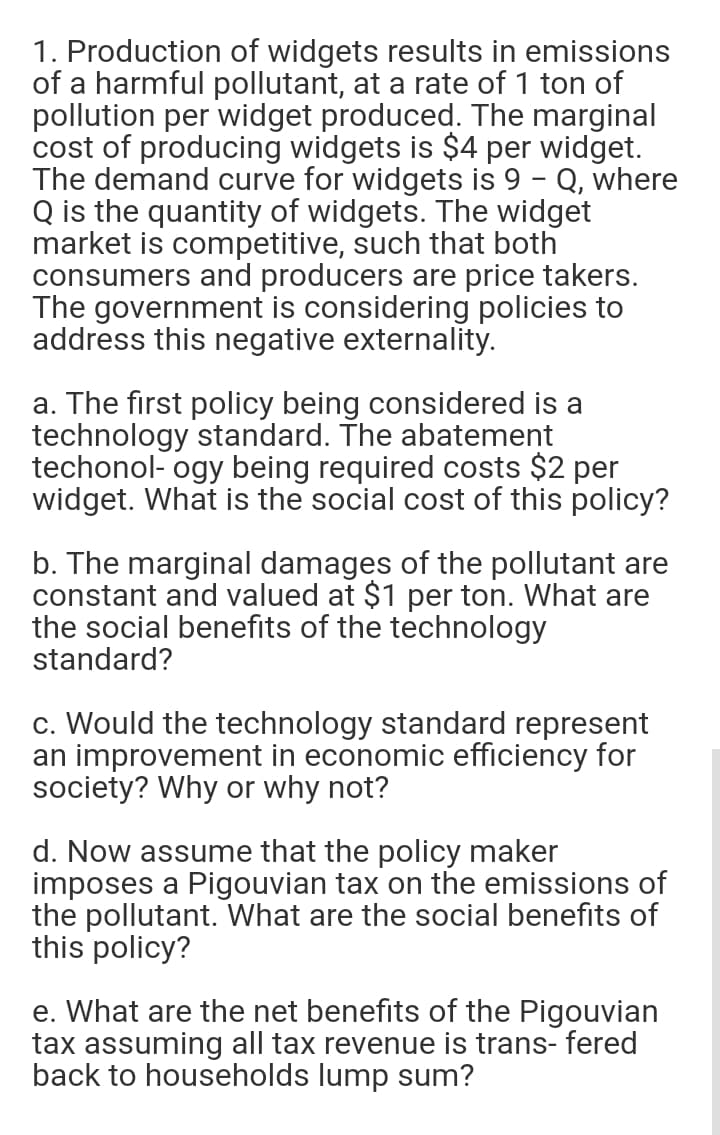1. Production of widgets results in emissions of a harmful pollutant, at a rate of 1 ton of pollution per widget produced. The marginal cost of producing widgets is $4 per widget. The demand curve for widgets is 9 - Q, where Q is the quantity of widgets. The widget market is competitive, such that both consumers and producers are price takers. The government is considering policies to address this negative externality.
1. Production of widgets results in emissions of a harmful pollutant, at a rate of 1 ton of pollution per widget produced. The marginal cost of producing widgets is $4 per widget. The demand curve for widgets is 9 - Q, where Q is the quantity of widgets. The widget market is competitive, such that both consumers and producers are price takers. The government is considering policies to address this negative externality.
Principles of Economics, 7th Edition (MindTap Course List)
7th Edition
ISBN:9781285165875
Author:N. Gregory Mankiw
Publisher:N. Gregory Mankiw
Chapter10: Externalities
Section: Chapter Questions
Problem 5PA
Related questions
Question

Transcribed Image Text:1. Production of widgets results in emissions
of a harmful pollutant, at a rate of 1 ton of
pollution per widget produced. The marginal
cost of producing widgets is $4 per widget.
The demand curve for widgets is 9 - Q, where
Q is the quantity of widgets. The widget
market is competitive, such that both
consumers and producers are price takers.
The government is considering policies to
address this negative externality.
a. The first policy being considered is a
technology standard. The abatement
techonol- ogy being required costs $2 per
widget. What is the social cost of this policy?
b. The marginal damages of the pollutant are
constant and valued at $1 per ton. What are
the social benefits of the technology
standard?
c. Would the technology standard represent
an improvement in economic efficiency for
society? Why or why not?
d. Now assume that the policy maker
imposes a Pigouvian tax on the emissions of
the pollutant. What are the social benefits of
this policy?
e. What are the net benefits of the Pigouvian
tax assuming all tax revenue is trans- fered
back to households lump sum?
Expert Solution
This question has been solved!
Explore an expertly crafted, step-by-step solution for a thorough understanding of key concepts.
This is a popular solution!
Trending now
This is a popular solution!
Step by step
Solved in 2 steps

Knowledge Booster
Learn more about
Need a deep-dive on the concept behind this application? Look no further. Learn more about this topic, economics and related others by exploring similar questions and additional content below.Recommended textbooks for you

Principles of Economics, 7th Edition (MindTap Cou…
Economics
ISBN:
9781285165875
Author:
N. Gregory Mankiw
Publisher:
Cengage Learning

Principles of Economics (MindTap Course List)
Economics
ISBN:
9781305585126
Author:
N. Gregory Mankiw
Publisher:
Cengage Learning

Essentials of Economics (MindTap Course List)
Economics
ISBN:
9781337091992
Author:
N. Gregory Mankiw
Publisher:
Cengage Learning

Principles of Economics, 7th Edition (MindTap Cou…
Economics
ISBN:
9781285165875
Author:
N. Gregory Mankiw
Publisher:
Cengage Learning

Principles of Economics (MindTap Course List)
Economics
ISBN:
9781305585126
Author:
N. Gregory Mankiw
Publisher:
Cengage Learning

Essentials of Economics (MindTap Course List)
Economics
ISBN:
9781337091992
Author:
N. Gregory Mankiw
Publisher:
Cengage Learning

Principles of Microeconomics (MindTap Course List)
Economics
ISBN:
9781305971493
Author:
N. Gregory Mankiw
Publisher:
Cengage Learning

Principles of Microeconomics
Economics
ISBN:
9781305156050
Author:
N. Gregory Mankiw
Publisher:
Cengage Learning

Principles of Economics 2e
Economics
ISBN:
9781947172364
Author:
Steven A. Greenlaw; David Shapiro
Publisher:
OpenStax